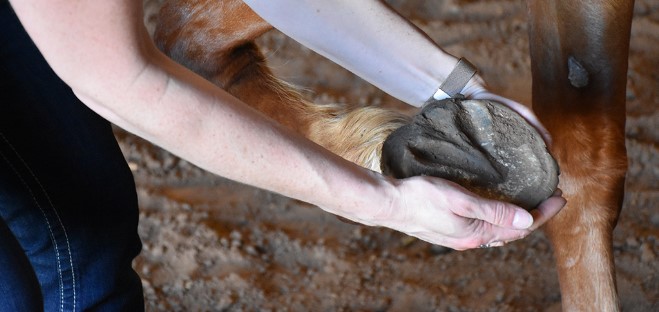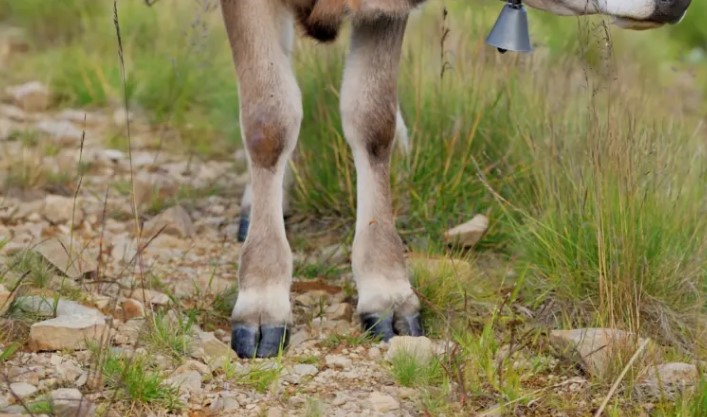Crafted by a team of equine and cattle health experts, this enlightening exploration into hoof care will lead you down a path less trodden. It reveals a fascinating world where each stride a horse or cow takes matters. Here, we unravel why horseshoes are a necessity, yet cows roam comfortably shoeless. This is a testament to the wisdom of nature, the power of evolution, and the vital role humans play in caring for these animals. In this article, we will discuss about “Why do Horses Need Shoes But Not Cows?” in detail. Keep reading!
Exploring Equine Hoof Care: The Vital Role of Horseshoes

Horses and their hooves have a unique relationship, with each relying on the other for strength and endurance. The wild ancestors of today’s horses evolved to roam vast expanses, gradually hardening their hooves. However, with domestication and varied tasks, many horses now need additional support, entering the arena of horseshoeing.
Horseshoes act as the barrier between the horse’s hoof and hard, unnatural surfaces, like concrete, which they often traverse. This shielding prevents injuries and lameness, maintaining the horse’s athletic prowess. Moreover, shoeing can also correct hoof abnormalities, ensuring the horse maintains a balanced gait.
As many horse owners will testify, a healthy hoof signifies a healthy horse. Regular farrier services are a must, ensuring the hoof’s growth is managed, and the horseshoe is aptly fitted. The need for frequent changes in horseshoes cannot be overstated, usually ranging between 4-6 weeks.
So, are horseshoes necessary for all horses? Not necessarily. Horses that are kept for light riding or as pasture pets might not need them. However, for performance horses, the protection and support horseshoes provide are often indispensable.
Cow Hoof Health: Why Cows Can Walk Barefoot

While horses and cows may seem similar at first glance, they differ significantly in their foot structure and lifestyle. This difference means cows can generally go shoeless, unlike horses.
A cow’s hoof, unlike a horse’s, splits into two digits. This evolutionary adaptation suits the cow’s slower, more placid lifestyle and allows for better balance and traction on varied terrains. A cow’s hoof is not subjected to the same rigorous activities as a horse’s hoof, reducing the need for extra protection or support. Cattle also have a different walking pattern, which distributes weight more evenly across their hoof, further reducing stress and potential damage.
That said, cows are not exempt from hoof care. Routine hoof trimming and attention to their living conditions are still needed. The goal here is to prevent overgrowth and common conditions like foot rot, promoting overall hoof health.
Equestrian Echoes: Can Horses Go Without Shoes?

The world of equine hoof care has seen recent trends advocating for “barefoot” horses, much like their cow counterparts. Some proponents argue that given the right environment and care, horses can adapt to a shoeless life. A strong emphasis is placed on regular trimming to mimic the natural wear and tear wild horses experience.
However, the move to barefoot horses is not a one-size-fits-all solution. The lifestyle and use of the horse, along with its individual hoof structure and health, play a crucial role in deciding whether shoes are necessary.
This journey into the realm of hoof health unravels the intriguing world of horseshoes and barefoot cows. By embracing the distinct needs of these incredible creatures, we can ensure they gallop and graze healthily and happily. Here’s to forging ahead, one hoof at a time.
Sources: Farrier Services and Horse Hoof Anatomy: “The Horse”, American Association of Equine Practitioners Cow Hoof Structure and Cattle Foot Care: “Dairy Hoof Health”, Dairy Research and Extension Consortium of Alberta Hoof Maintenance in Livestock: “Foot Care in Beef Cattle”, The Beef Site Differences in Hoof Structure between Horses and Cows: “Comparative Foot Structure and Function”, American Farriers Journal.
The Physiology of Hoof Wear: Differing Demands of Horses and Cows
Delving deeper into the realm of hooves, it becomes crucial to understand the distinct physiological demands placed on horses and cows, which dictate their differential hoof wear and the consequent need for shoeing in horses.
A Day in the Life of a Horse’s Hoof
Imagine the sound of a galloping horse – the powerful rhythmic thud of hooves hitting the ground. Whether it’s a racehorse speeding on a track or a working horse pulling heavy loads, the horse’s hooves endure intense pressures and high-impact forces. This stress can lead to wear and tear, causing injuries if not mitigated.
Additionally, domestic horses often walk or run on surfaces far harder than what their wild counterparts would encounter. Prolonged exposure to these unnatural environments can lead to accelerated hoof wear and potential damage. Hence, horseshoes are utilized to absorb shock and reduce wear, thus protecting the hoof from injury.
The Tranquil Trot of a Cow
In contrast, cows lead a more sedentary lifestyle. They spend a significant amount of time lying down and their movements are generally slower and less forceful than those of horses. As a result, their hooves experience less wear and tear.
Cows also predominantly walk on softer terrains, like grass or mud, which are more akin to their natural environments. These softer surfaces cause less wear on their hooves, reducing the need for protective shoes.
A Lesson from the Wild: Do Wild Horses Need Shoes?
When contemplating why domestic horses need shoes while cows do not, one might wonder about wild horses. They live in herds, run free, and nobody is showing them. So, how do they manage?
Wild horses travel over a variety of natural terrains daily, leading to natural self-trimming and hardening of their hooves. Additionally, only the fittest survive in the wild. Those with weak or defective hooves might not survive to reproduce, thereby strengthening the gene pool.
However, most domestic horses don’t live like their wild cousins. They often reside in small pastures or stalls, restricting their movement, and subsequently, natural hoof wear. Therefore, human intervention becomes necessary to maintain hoof health, leading to the use of horseshoes in many cases.
The Future of Hoof Care: Innovations and Alternatives to Horseshoes
As technology and research advance, alternatives to traditional metal horseshoes are emerging. Horse booties, glue-on shoes, and composite shoes offer more flexibility and can mimic the natural flex of a horse’s hoof, making them a popular choice for some owners.
Each type of hoof protection has its own set of benefits and drawbacks, and the best option varies depending on the individual horse’s needs. The constant, however, remains the same – regular, professional hoof care to ensure the horse’s health and well-being.
FAQs: Why do Horses Need Shoes But Not Cows?
1. Can horses go without shoes?
Yes, depending on the horse’s lifestyle, terrain, and individual hoof health. Regular hoof care is still necessary to prevent overgrowth and other issues.
2. Do cows need hoof care like horses?
Yes, though they don’t require shoes, cows still need regular hoof trimming and care to prevent overgrowth and disease.
3. Can cows develop hoof problems?
Indeed, cows can develop hoof issues like overgrowth and foot rot. Regular hoof care and monitoring can help prevent these problems.
4. Why are horse hooves different from cow hooves?
Horse and cow hooves have evolved differently based on their lifestyles. A horse’s hoof is a single, solid structure, while a cow’s hoof splits into two digits.
Also Read: How to Clean Hoka Shoes? (Thoroughly Explained in 15 Steps)
A Closing Thought on Why do Horses Need Shoes But Not Cows?
Through this exploration, we unravel the fascinating world beneath the horse and cow – the story of their hooves. From galloping horses to grazing cows, the contrast in their lifestyles and their hoof structures explains why horses often need shoes while cows do not.
As we continue to work alongside these animals, we must remember the vital importance of proper hoof care in ensuring their health and happiness. By doing so, we honor the centuries-old bond between humans and these remarkable creatures.

A captivating wordsmith and dynamic blogger. With her pen as her wand, she weaves enchanting tales and thought-provoking insights that leave readers spellbound. Embrace the magic of her storytelling prowess and embark on an unforgettable literary journey with this talented writer.
